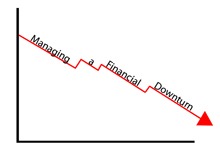Managing a Financial Downturn
Posted At: October 21, 2009 1:52 PM
by Ashley Ross
 In today’s lackluster economy, more and more companies are searching for ways to keep their heads above water. Companies rely on public relations more than ever to create optimistic financial outlooks for the public. For a company to survive these difficult economic times, it is key that public relations practitioners understand how to communicate a positive company reputation, despite negative financial issues.
In today’s lackluster economy, more and more companies are searching for ways to keep their heads above water. Companies rely on public relations more than ever to create optimistic financial outlooks for the public. For a company to survive these difficult economic times, it is key that public relations practitioners understand how to communicate a positive company reputation, despite negative financial issues.
Forming potential strategies to combat declining monetary issues should be the first undertaking for companies to maintain a positive public image during tough times. Preparation is the single most important step in managing financial crises.
Jonathan Bernstein, president of Bernstein Crisis Management Inc., located in California, holds more than 25 years of experience within the field of crisis management. He agrees preparation is crucial. “The first step is intelligence gathering,” Bernstein said. “I play investigative reporter, only on behalf of the company. It’s vital to know the truth of the matter before finalizing strategy and messages.”
As General Motors knows all too well, without a plan, failure is eminent. John McDonald, GM’s spokesman for consumer incentives, sales and marketing trends said, “We didn’t react. For us, it was a matter of planning and then executing the plan.”
GM filed for Chapter 11 bankruptcy in early June 2009. GM then hired Bob Lutz to update its advertising, internal communications and public relations. The public relations department determined GM’s course of communication throughout the bankruptcy, and Lutz was there to make sure the job was completed. With much dedication and diligence, the company came out of bankruptcy by July 10, 2009. McDonald said, “GM’s departments focused their attention toward minimizing the damage to their reputation, supporting customers and businesses and ultimately securing financing and reorganizing the company.”
GM began preparing to restructure the organization more than a year ago. “We had communications programs around that were modified, and as the plan changed over time, the preparation and restructuring shifted,” McDonald said. Initially, it was estimated that GM needed 90 days for restructure during bankruptcy; to the surprise of many it only took it 40. GM accomplished such a feat through its “Reinvention” campaign, which launched immediately after filing for bankruptcy. The campaign included a Web site with links to the GM Twitter, Facebook and other social media accounts and a 60-second spot that appeared on YouTube, Facebook, television and radio.
What exactly did the campaign do for GM? “The campaign showed customers and the public how we were changing,” McDonald said. “It was successful for GM by the fact that we secured government funding and maintained market share.”
When asked about the role of public relations during a bankruptcy, Bernstein said, “To the greatest extent possible, it preserves the reputation of the principals involved and also effectively lets stakeholders know what the bankruptcy means to them.”
In order to regain the trust of the public, customers and stakeholders, the GM “Reinvention” openly and honestly explained the issues it encountered while facing bankruptcy. For example, the “Reinvention” commercial GM launched said, “Let’s be completely honest. No company wants to go through this, but we’re not witnessing the end of the American car. We’re witnessing the rebirth of the American car. GM needs to start over in order to get stronger.”
Bernstein said the ultimate goal is to minimize damage. GM’s efforts throughout bankruptcy exemplified this same belief. Not only does a company have to minimize the damage done within the infrastructure during bankruptcy, but it must also be conscious of the damage stakeholders and customers will endure and handle it accordingly.
With the goals set and the right preparation on hand to achieve those goals, a company will create an increased opportunity to have a better financial standing. To help a company through it all, public relations should be at the forefront of the situation, managing the entire process by laying out the groundwork and ultimately accomplishing the goal of minimizing damage.
Any company facing financial downturns during this recession can look to GM’s situation to prepare for such financial binds and learn how to manage crises within their businesses. GM’s Bob Lutz and its public relations department accomplished numerous feats while GM rose out of bankruptcy. GM’s biggest challenge was winning back faith of the public, but McDonald advised, “You can’t just talk about change, you have to show the change.”
Graphic by Niki Gautier


